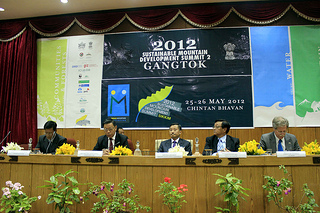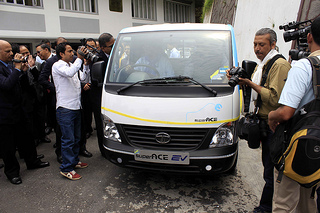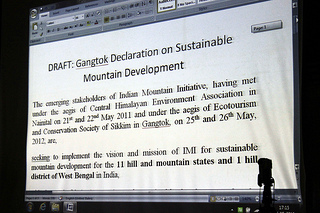Around 250 delegates from eleven hill states of India along with representatives from Darjeeling hills participated in the two days summit. It was organized by Ecotourism and Conservation Society of Sikkim (ECOSS) jointly with Central Himalayan Environment Association (CHEA).
‘To make sustainable development a reality, not a mere slogan’
The first day of the summit began with the inauguration of the event by Sikkim Legislative Assembly Speaker KT Gyaltsen by lighting the lamp. Karma Gyatso, Chief Secretary, government of Sikkim in his welcome address said that IMI is a civil society movement that aims to bring together 11 Himalayan states of India, and the district Darjeeling to discuss and debate pressing issues facing the mountain states, and to evolve consensus on the approach to address them.
IMI was setup in recommendation to the most recent Indian planning commission’s task force of 2011 on hill states, and hill area underlying the need for a common platform for Indian Himalayan Region (IHR) for regular interaction and from therein, decide on a common essential plan for the region. The theme of this year’s summit was water, community and forests, and mountain livelihoods.
“The agenda of sustainable development is central to the vision of the government of Sikkim. It is the cornerstone of the cultural ethos of the state. The government of Sikkim has initiated policies to ensure that steps are taken in right directions to make sustainable development a reality, and not a mere slogan,” he said.
The welcome address was followed by speech from PD Rai, Lok Sabha Member of Parliament (MP) from Sikkim and convener of the summit. In his address he said that the IMI summit is an event to bring together the hilly regions to discuss on the themes that are vital to the development and well being of the region. It is to ensure that all Indian mountainous states which presently have no mechanisms in place will be provided one such platform where all stakeholders could hold open discussion on issues relating to environment and sustainable development from time to time, he said.

From right - Dr David Molden, Director General of ICIMOD,Kathmandu, Karma Gyatso, Chief Secretary, Government of Sikkim, KT Gyaltsen, Speaker, Sikkim Legislative Assembly, PD Rai, Member of Parliament and convener IMI
‘To increase the happiness index of the people’
Speaker Gyaltsen in his inaugural address said that the Sikkim government’s initiatives in the preservation, conservation and sustainable use of ecosystem have made its own contributions based on far-sightedness policies, plans and programmes of the government. He said the ultimate aim of the government was to protect and preserve the ecology of the state thereby increasing the happiness index of the Sikkimese people.
Underlying the importance of culture for protection of the state’s bio-resources, Gyaltsen said that by the virtue of the culture and religious sentiments, mountains and lakes are revered by the people in Sikkim as the abode of deities. As Kanchenjunga is the guardian deity of Sikkim, activities which defile such sacred spots are not allowed, he said.
He therefore stressed that the sense of protection and conservation of Mother Nature needs to be instilled in everyone and hoped that the outcome of two days’ deliberations would be constructive and tangible.
Keynote address
The keynote address was delivered by the Director General of ICIMOD Kathmandu Nepal, Dr David Molden. In his presentation on ‘mountain, climate change and rapidly diminishing hill bio-resources and energy generating capability,’ he said that forty percent of the world population depended on mountain water resources. However, these resources are being stretched due to growing population, land degradation, climate change, shrinking of thousands of glaciers, urbanization and energy requirements, he observed. But he also said that mountain do offer solution to the issue of water scarcity. The vulnerability of hill people to floods and droughts can be reduced by early warning systems and generation of clean energy through hydro power can address the black carbon issue, he said.
Low carbon emission cars unveiled
During the summit, the Tata Motors displayed its Tata Super Ace Electric utility vehicle that uses low carbon technology. It was inaugurated by Pema Khandu, Tourism Minister, Arunachal Pradesh. One model each of Nano CNG and Super Ace Electric vehicles from the Tata stable were put up for display and demonstration at the summit venue.
The Tata Nano CNG comes with a touring range of more than 150 km in addition to the existing touring range (375 km) of the Nano 2012, improved emissions with low CO2, best-in-class fuel economy, resulting in low running cost. The Tata Super Ace EV is equipped with a lithium-ion battery for energy storage, electric motor and controller. It delivers a top speed of 80 km/h forward and 30 km/h reverse.

Super ace electric vehicle unveiled by Tata Motors on display
Technical sessions
Three technical sessions on Water, Community Forests and Mountain Livelihoods followed post lunch on the first day of the summit. The key speakers were Amardeep Singh Bhatia, Secretary Commissioner & Team Leader of NEPeD projects, Dr. Eklabya Sharma, Director, Programme Operations, ICIMOD and Dr. Ravi Chopra, Director, People's Science Institute, Dehradun.
Dr. Ravi Chopra from People's Science Institute, Dehradun presenting on Himalayan water resources
Thematic group discussion
On the second day of the summit, the delegates were divided into three thematic groups – Water, Mountain Livelihood and Community Forests for discussion. The theme on Mountain Livelihood was facilitated by ECOSS and IIM Shillong, on Water by ATREE and on Community and Forests by WWF, India.
In the thematic discussion on water, Dr Sandeep Tambe, Additional Secretary, Rural Management and Development Department, government of Sikkim presented a paper on ‘Environmental change, Water Security, Traditional Systems and Innovation in the Himalayas’. Prof Chandan Ghosh, North Eastern Hills University (NEHU), Shillong presented a paper on ‘Water hazards’. Dr Sumit Sen, ATREE, Sikkim presented a paper on ‘Water rights, Policy and Governance’.
The Gangtok Declaration
The IMI summit concluded on the second day with the announcement of ‘Gangtok Declaration’ by PD Rai with the decision to carry on the momentum for the third summit proposed to be held at Kohima, Nagaland next year. The declaration resolved that the mountain States in India have not received the attention due to them and it recommends that greater focus and emphasis be given to the Sustainable Mountain Development agenda without delay and continued for the next 20 years.
The draft of ‘Gangtok Declaration’ was placed with ten mandates for IMI at the valedictory session for approval by the delegates. It identified that the unique needs and aspirations of each state, mountain region and their people to be taken into account by IMI in an inclusive way with the aim of making fundamental shifts in their understanding and behavior. The declaration highlighted that hill and mountain people are at the centre of concerns for sustainable development and are entitled to improved livelihoods in harmony with the environment.

The ‘Gangtok Declaration’ presented by Summit convener, Lok Sabha MP PD Rai before the delegates after two days of engagements on water, mountain livelihood and communities & forests
All mountain states also agreed to cooperate on building awareness and capacity for action on adaptation and transfer technologies and practices for sustainable development. The declaration recognized the role of women of mountain areas in livelihood generation and protection of environment. It further sought to develop appropriate institutionalization mechanisms to build movement and momentum towards achieving the goals of IMI through an inclusive organization structure, network, systems and process.
Presentation of the ‘Gangtok Declaration’ was followed by each participant from mountain states committing to take IMI forward.